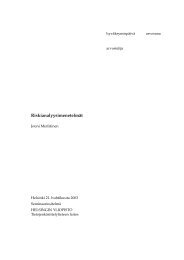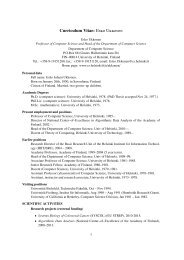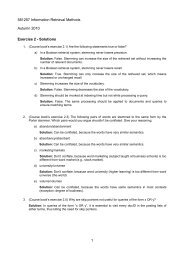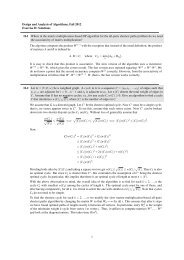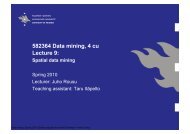Toni Sihvonen (order #92780) 62.142.248.1
Toni Sihvonen (order #92780) 62.142.248.1
Toni Sihvonen (order #92780) 62.142.248.1
Create successful ePaper yourself
Turn your PDF publications into a flip-book with our unique Google optimized e-Paper software.
~ ~<br />
<strong>Toni</strong> <strong>Sihvonen</strong> (<strong>order</strong> <strong>#92780</strong>) 6<br />
Phases 2-4 After Badon<br />
519-554<br />
Kent, Est Saexe, West Saexe, Suth Saexe, and Anglia suffer<br />
months of plundering and colonization by the victorious<br />
Britons. Arthur awards these territories to landless knights<br />
- often de Canis men or British nobles displaced by the<br />
Saxons -who rule them as dukes or earls (a Saxon title,<br />
from ealdorman) sworn to Arthur. In Phases 2-3, these<br />
new lords introduce feudalism, chivalry, and Christianity,<br />
presenting Arthurian values as either a carrot (under the<br />
forgiving Kynniarc of Kent) or a stick (under the vengeful<br />
Hervis of Anglia) to their Saxon subjects. The disaster at<br />
Badon leaves many Saxon widows and orphans. The<br />
colonist knights marry these widows, bringing their lands<br />
and families under British control: the orphans are fostered<br />
by families in Logres or by the Church. Starting<br />
around 525, they enter adulthood as Saxon knights.<br />
Although Christianity and medieval ways take root in the<br />
happier Saxon kingdoms, Saxon belligerence and paganism<br />
bubble under the surface. Saxon bandits plague<br />
unconquered forests like Quinqeroi, home of the evil Sir<br />
Turquine. Small raids or conspiracies are led by goderes or<br />
wiccas in the name of the war gods. Saxon widows like<br />
Cwene Gunnhild of Lindissi and Cwene Ethfrida of<br />
Nohaut become haegtesses: magicians inspired by the<br />
Hate passion: others join Freija’s Women, the female<br />
fighting <strong>order</strong> described in Pendragon page 143. Major<br />
Saxon rebellions that require the Round Table’s attention<br />
do not occur in these phases except in Anglia, which<br />
rebels in 520, and again in 529-31, led by the haegtess<br />
Lady Camille.<br />
The northern Saxon territories of Lindissi, Deira, and<br />
Nohaut are far from King Arthur’s supervision. Instead,<br />
they submit to - or hide from, or raid - the King of a<br />
Hundred Knights: a formidable foe even to Arthur, his<br />
nominal liege. The northern Saxons still raid up and<br />
down the Cumbrian coast. They even form an independent<br />
kingdom, Bernicia, in 547.<br />
519: King Barant of Malahaut reclaims Eburacum and<br />
begins reconquering the lands to the east.<br />
520: Angles rebel against Duke Hervis, who defeats them<br />
at the Battle of Fort Guinnon and slaughters their sons. In<br />
Jutland, Beowulf slays the monster Grendel for the<br />
Danish King Hrothgar.<br />
525: At Eburacum, King Barant forces Cyning Wilgils to<br />
swear fealty.<br />
Other developments: During these phases Arthur restores<br />
roads, towns, currency, the Church. and other Roman<br />
amenities.<br />
Phase 5: Pendragon Downfall, Saxon<br />
Reconquest<br />
555-577<br />
The Age of Arthur is destroyed by the wars of Lancelot<br />
and Mordred, the bloody Grail Quest, and many lesser<br />
betrayals and magics. The Saxon kingdoms rebel, and<br />
new invasions begin that overrun everything but Cambria<br />
and the northwest. By 601, when Pope Gregory’s deputy<br />
Augustine arrives at Canterbury to convert the Saxons,<br />
not a single church nor a single castle remains from the<br />
days of King Arthur.<br />
554 The Grail Quest begins. Many people rebel and raid<br />
while the Round Table knights are busy. Cynric leads an<br />
armada of Saxons to Britain and defeats Britons at Old<br />
Sarum.<br />
556: Cynric and Ceawlin defeat Britons at Beranburh<br />
(Barbury Castle).<br />
560: Ceawlin becomes cyning of Wessex. Aelle of Deira<br />
founds Northumbria.<br />
563: Civil war between Arthur and Lancelot. Saxons<br />
invite their kin from the continent to join raids.<br />
564 Mordred rebels against Arthur. He makes pacts with<br />
Saxon leaders, promising lands and kingdoms.<br />
565: Arthur defeats Mordred and the Saxons in Kent.<br />
Then Arthur defeats Mordred at Battle of Baram Down,<br />
and again at Camlann, where both Mordred and Arthur<br />
die, Aethelberht succeeds to the now-independent cyningdom<br />
of Kent.<br />
568: Ceawlin of Wessex defeats Aethelberht of Kent and<br />
declares himself Bretwalda. Battle of Wibbandum.<br />
570: Ceawlin and his brother Cutha conquer the<br />
Midlands and the Thames valley.<br />
571: Cutha defeats Britons at the Battle of Bedcanford.<br />
He dies later in the year.<br />
573: Saxons defeat Britons at the Battle of Catterick. The<br />
northeast falls under Saxon domination.<br />
577: Battle of Deorham. Saxons conquer Gloucester,<br />
Cirencester, and Bath. End of the Pendragon era.





